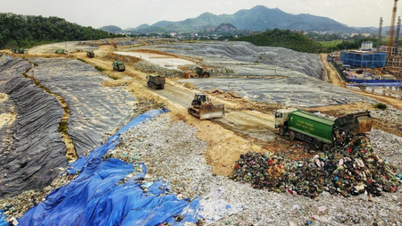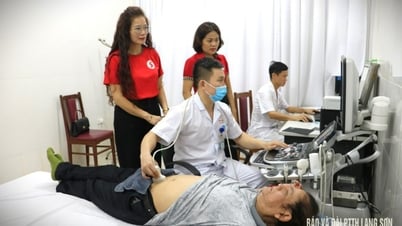Resolution XIII of the Central Committee sets the goal that by 2030, Vietnam will be a developing country with modern industry and high average income; by 2045, it will become a developed country with high income. Contributing to this goal, the automobile industry plays a key role in developing the economy , promoting growth, and improving people's lives.
 |
| Electric car production and assembly line of Vinfast Factory. |
To "direct" the Vietnamese automobile industry to develop in the right direction, it is necessary to objectively assess the current situation and draw profound lessons from the failures in implementing the previous Strategy for Automobile Industry Development to 2010, with a vision to 2020.
Policy is not close to reality
Since the early 90s of the last century, the Government has been very interested in setting strategic goals to develop the Vietnamese automobile industry to not only have enough output to serve domestic demand, but also set the goal of localizing products that meet export standards, including light trucks, passenger cars and spare parts, etc. On that basis, Vietnam has had key projects of both domestic enterprises and foreign joint ventures participating in investment in automobile production and assembly, but the projects have not achieved the set goals.
Entering the early 21st century, the Government continues to pursue the strategy of developing the automobile industry, building and promulgating many mechanisms and preferential policies, so that the automobile industry maintains a leading position, carries out industrialization and modernization of the country, keeps up with and surpasses countries in the region and the world.
On December 3, 2002, the Prime Minister issued Decision No. 175/2002/QD-TTg approving the Strategy for the Development of the Vietnamese Automobile Industry to 2010, with a vision to 2020, with the goal of developing the industry on the basis of absorbing and applying advanced world technology, combining exploitation and gradually improving technology and equipment, meeting 40%-50% of the domestic automobile market demand, aiming to export automobiles and spare parts. The strategy also sets a target of achieving a localization rate of 40% by 2005, up to 60% by 2010, of which the engine alone strives to achieve a localization rate of 50% and the gearbox 90%.
However, after more than 20 years of implementation, Vietnam still has no domestic enterprise or foreign joint venture that has achieved the strategic goals set by the Government, the localization rate is very low, instead, it is simply assembly, while components and spare parts still have to be imported from abroad. Is this because the industry development strategy policy is not close to reality, not in accordance with the objective requirements of the law of supply and demand, causing the results to not be as expected? In fact, automobile manufacturing enterprises invest in production lines mainly consisting of 4 stages: welding, painting, assembly, and inspection, so the product localization rate is only about 8% -10%, much lower than the strategic goal.
The Ministry of Industry and Trade also frankly admitted that the Vietnamese automobile industry can only produce a few types of simple spare parts with low technology content such as mirrors, glass, seats, wiring harnesses, batteries, tires, some plastic products, etc. Of the approximately 400 manufacturing and assembling enterprises, only a very few invest in car body and shell molding lines; most of the mold materials must be imported. In addition, every year, enterprises must import approximately 2-3.5 billion USD for components and spare parts and approximately 4 billion USD to import complete vehicles.
On July 16, 2014, the Government continued to issue Decision No. 1168/QD-TTg, approving the strategy for developing the Vietnamese automobile industry to 2025, with a vision to 2035, identifying this as an important driving force for industrialization and modernization, and should be encouraged to develop with stable, consistent and long-term policies. The target is to reach output of more than 466,000 units by 2025, and more than 1.5 million units by 2035, with the proportion of domestically produced and assembled vehicles accounting for about 78%.
By 2035, electric vehicles will be mainstream
According to the Vietnam Register, in 2022, the total number of cars sold nationwide will only reach more than 407,000. The ASEAN and East Asia Economic Research Institute calculates that the car sales volume of about 400,000 units/year as above is only equivalent to Thailand and Malaysia in the 1990s and Indonesia in the mid-2000s. The rate of car ownership in Vietnam is still much lower than that of other countries in the region, and the auto industry is slow to develop. Many auto experts believe that for the Vietnamese auto industry to truly develop, our country needs to reach a consumption level of about 600,000 cars/year. Strategic policy-making agencies must have breakthrough mechanisms and prioritize development so that by the early 2030s, the car market consumption in Vietnam can reach 1 million cars/year.
Experts believe that to achieve this important goal, it is necessary to seriously review and re-evaluate the implementation process and progress of the Automobile Industry Development Strategy to 2010, with a vision to 2020, and to adjust regulations that are no longer suitable for the development of the automobile industry in the world. It is necessary to study and evaluate the future development trend of automobiles, which is to use clean, environmentally friendly fuels such as electric vehicles, hybrid-electric vehicles, etc., while technologies using internal combustion engines such as gasoline and oil will gradually be eliminated. In addition, there should be a comprehensive policy to improve people's income and make car prices more accessible to consumers.
Currently, the trend of electrifying cars is taking place strongly in the world. For electric cars, the starting point between Vietnam and ASEAN countries is basically equal. If in the past, for internal combustion engine cars, the car engine was the "heart", containing the essence of technology, now, for electric cars, it is the battery - an important component that our country has many favorable conditions to develop.
The potential to attract investment projects in the production and assembly of electric cars and electric car batteries in Vietnam is huge if relevant ministries and sectors soon research and issue preferential policies, promptly support consumers and car manufacturers in accordance with the Government's direction. This issue not only solves the "problem" of promoting the development of environmentally friendly vehicles but also helps stimulate purchasing power and accelerate the development of the automobile industry.
It should be added that neighboring countries are "racing" to expand mechanisms and preferential policies to attract investors to develop electric vehicles. If our country does not quickly seize this "golden opportunity", it will continue to miss the beat and repeat the mistakes of the past. The target of exporting 90,000 cars and exporting spare parts and components to reach 10 billion USD by 2035 stated in the Strategy to 2025, vision to 2035 will not be achieved without timely assessment to adjust and overcome shortcomings in each stage, and at the same time have policies to promote industry development according to the world's development trend of electric vehicles and clean energy vehicles.
In order for the country's automobile industry not to be left behind and make the same mistakes as before, the Government and ministries and branches need to promptly review and evaluate the progress of implementing the Automobile Industry Development Strategy to 2025, with a vision to 2035, seriously acknowledge the remaining limitations, and promptly adjust the goals to match regional and global trends.
In addition, the Government has assigned political responsibilities and powers to each ministry in advising and assisting the Prime Minister to successfully implement the proposed Strategy for the Development of the Automobile Industry. At the same time, it is necessary to update and promulgate the Strategy for the Development of the Electric Automobile Industry in Vietnam to take advantage of opportunities and keep up with the development trends of the automobile industry in the future. Every year, ministries and branches periodically evaluate and summarize the implementation progress and achieved/unachieved results, publicly announce them to adjust, learn from practical experience, supplement and promulgate appropriate policies like other countries in the region, and institutionalize the important goals set forth in the Resolution of the 13th Central Committee.
Source: https://nhandan.vn/nganh-cong-nghiep-o-to-yeu-to-then-chot-phat-trien-nen-kinh-te-dat-nuoc-post794144.html
Source









































































































Comment (0)